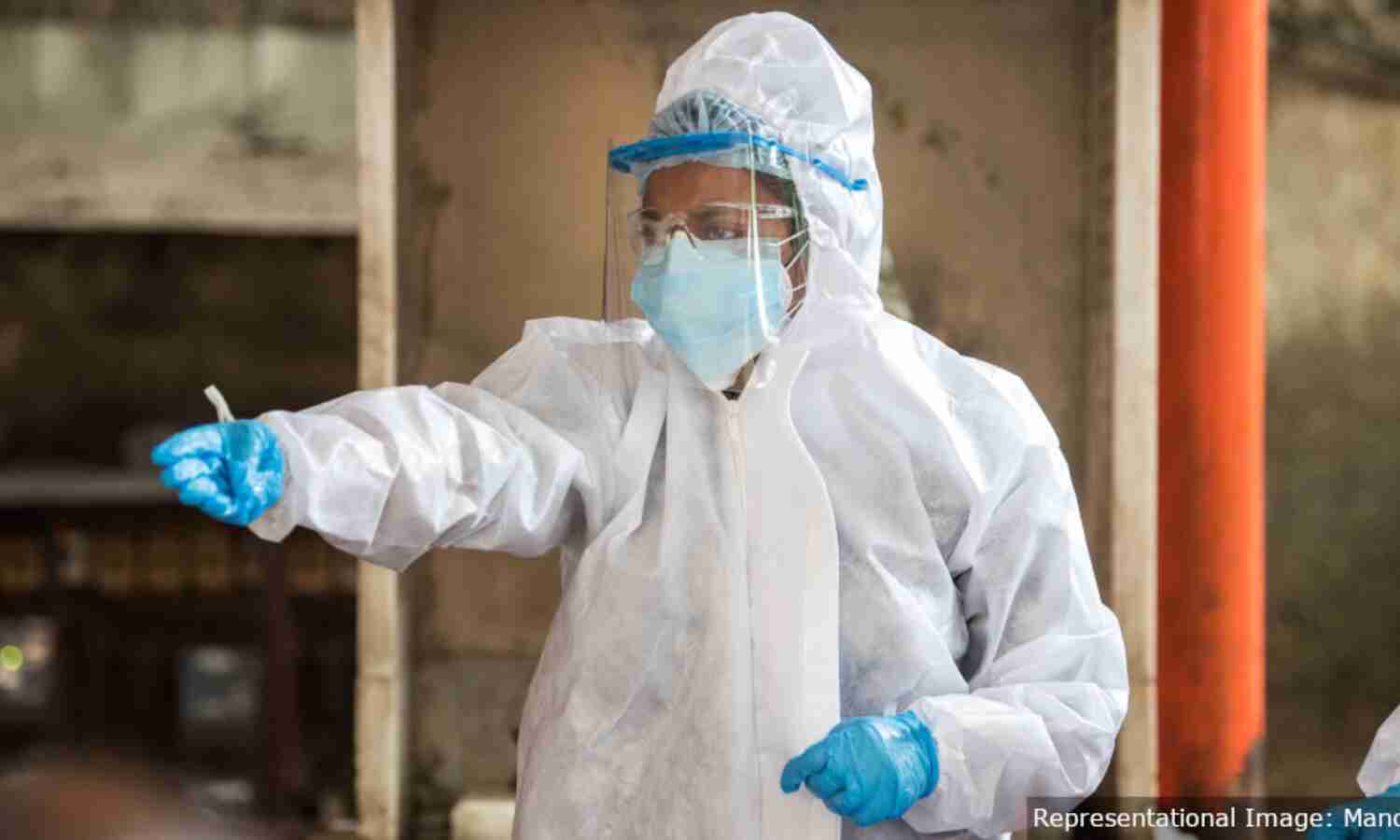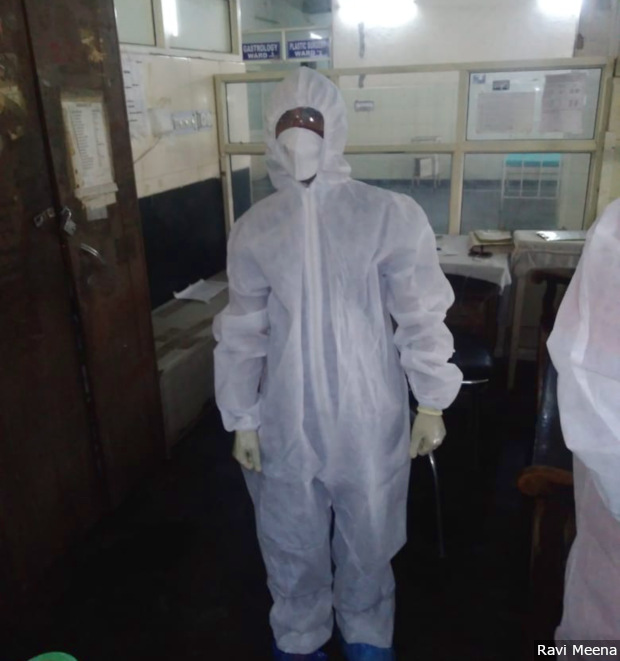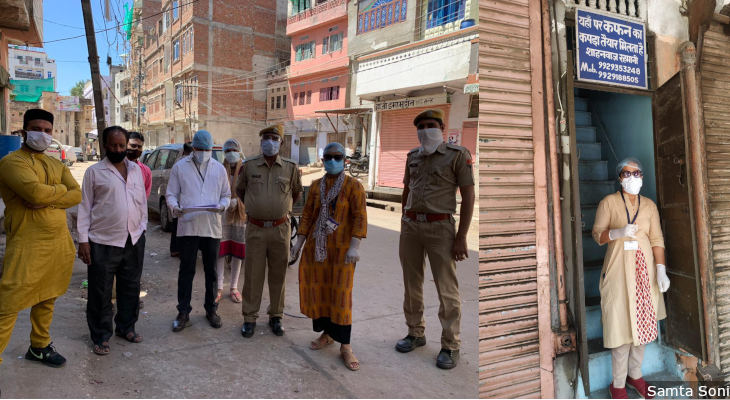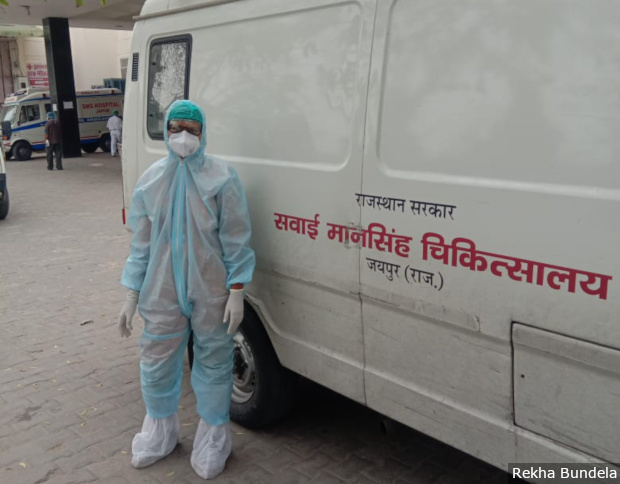How Jaipur Has Kept Its Health Workers Motivated Through The Pandemic

Jaipur and Delhi: Timely provision of on-demand testing for COVID-19, quarantine facilities, protective gear, and humane work conditions with fixed shifts and on-time salary ensured that Jaipur’s health workforce stayed motivated all through the ongoing pandemic, IndiaSpend found in an investigation. These factors allowed the city to build a robust network of confident medical staff who stayed focussed on patient care at the worst of times.
In contrast, public and private healthcare workers in most cities including Delhi, Mumbai, Bengaluru, Kolkata, Hyderabad and Ahmedabad have relayed stories of long working hours, inadequate protective gear, delayed testing and partial or delayed salary payments.
If hospitals and state authorities take care of healthcare workers, it reduces the chance of a staff shortage caused by an outbreak at facilities. Greater precaution and screening in hospitals prevents them from becoming hotspots and reduces the possibility of workers carrying the disease into their communities.
Basic facilities, such as access to testing and adequate rest, become even more important for health workers because of the additional burden and emotional exertion of taking care of patients while isolated from family and facing stigma in the community about COVID-19, the workers said.
“Our strategy ensures that health workers do not get tired and are motivated,” said Narottam Sharma, Jaipur’s Chief Medical and Health Officer (CMHO). The city also had the advantage of preparing early for COVID-19--by the end of February, pointed out Sudhanshu Kakkar, principal and controller of the Rajasthan University of Health Sciences (RUHS), currently the largest dedicated COVID-19 government facility in the city.
Rajasthan reported its first case of COVID-19 on March 2 when a 68-year-old Italian tourist tested positive in Jaipur. The state’s tally crossed 100 cases on April 2, eight days after Kerala and Maharashtra. As of July 26, Rajasthan has had 35,787 cases of COVID-19, of which 9,935 cases are active, less than a fifth of the active cases reported in Tamil Nadu, Karnataka and Andhra Pradesh. The number of confirmed cases in Jaipur is the second highest across districts in Rajasthan, after Jodhpur, with 4,848 cases, of which 1,080 were active as of July 26.
We did encounter some cases where health workers faced issues--lack of personal protective equipment (PPE), postponement of retirements and denial of salaries--but these were scattered and few.
Getting over early fears
Wearing long boots, goggles, N-95 masks, gloves and a cap, Ravi Meena and about 200 sanitation workers ensured cleanliness and hygiene at the main building of the Sawai Man Singh (SMS) hospital, which was Jaipur’s biggest COVID-19 facility till May 31 when active cases in the city started declining. At one point, the hospital had over 600 COVID-19 patients.
“We were scared at first but when some of our colleagues tested positive and successfully recovered, our confidence grew,” said the 26-year-old sanitation supervisor. Sanitation workers are at risk of contracting COVID-19 through contact with hospital patients and discarded medical waste.

Ravi Meena, 26, a cleaning supervisor, at the main building of Sawai Man Singh Hospital in April 2020.
It was not easy when the first COVID-19 cases were admitted in the hospital, workers recalled.
“The first patient was admitted in my ward on April 7 and until the night before we were very stressed, spending sleepless nights with concerned family members. After a week the fear went away,” said Ramchandra Verma, a nurse who is in-charge of the general surgery ward at SMS Hospital in Jaipur.
“When we went to drop the first patients off at the hospital, the guards ran away because they were so scared,” recounted Rekha Bundela, a 33-year-old critical care ambulance nurse in SMS hospital.
At RUHS, which now has 500 beds and 40 intensive care beds for COVID-19 patients, some sanitation workers “ran off” or refused to work when the facility became a COVID-19 hospital, said Kakkar, the principal. “It took four-five hours to explain to them that nothing will happen to them. I went in with a ward boy to increase their confidence,” Kakkar said.
Preventing overwhelmed hospitals
To avoid staff shortage, Jaipur extended the tenure of retiring healthcare workers, transferred staff from less busy health centres and hired more workers, the CMHO and hospital administrators of two government COVID-19 facilities told IndiaSpend. Because salaries were mostly paid on time and staff were taken care of, existing workers did not strike or resign en masse, as observed in other cities.
To help reduce the burden on hospital staff, “the government of Rajasthan also deployed 100 staff from smaller dispensaries [in and around Jaipur] to SMS to help the response”, said Neeraj Jain, secretary to the principal of SMS.
“Initially, 10 neighbouring districts fed into the [SMS] hospital, which led to confusion and crowding,” said Verma. “But as dedicated hospitals were set up in other districts, the situation improved.” This also reduced the staff workload. For instance, in April, the 30-bed ward at SMS that Verma managed operated at full capacity with many cases from areas near Jaipur. But by the end of May, as many as 25% of the beds in the ward were vacant, he said.
The government also extended the tenure of those health workers who were retiring in March and April to September 5, said Sharma, the CMHO. The government has recruited about 75 nurses to replace the staff when their extended tenure ends, Sharma added.
Some workers whose tenure was extended complained that they have not been paid since April because of a software glitch, said Sushma Jain, 61, an auxiliary nurse and midwife (ANM), who was due to retire on March 31 but has been retained till September. Sharma said he would look into her case. No regular health worker, on contract or otherwise, has complained about delays in salaries, said the CMHO and other healthcare workers who spoke to IndiaSpend.
RUHS, the other major COVID-19 hospital, is supported by healthcare workers from elsewhere. “RUHS is a big hospital but it is poorly staffed. They only saw 400 to 500 patients per year before this,” said Abhishek Agarwal, a senior professor in the Department of Medicine at SMS. RUHS had only 70-80 nursing staff and the team was supplemented with staff from SMS after May [once SMS was turned to a non-COVID-19 facility] and from other peripheral health centres with lower workload, said Kakkar.
Ensuring protective equipment
Unlike other cities, medical staff in Jaipur said they did not feel unsafe at work because they had adequate protective gear. Samta Soni, a community health nurse and faculty member at the SMS College of Nursing, was posted to Jaipur’s Ramganj area, one of the early COVID-19 hotspots, to carry out door-to-door screenings between March 11 and April 17. Her team of 80 were supplied with ample gloves, masks and sanitiser, she said.

Samta Soni, a community health nurse and faculty member at the SMS College of Nursing, Jaipur, carrying out door-to-door surveys in the city’s Ramganj area, a COVID-19 hotspot, in March 2020.
Within COVID-19-dedicated wards, workers were provided PPE that was disposed of after every instance of exposure, said Verma. However, PPE items were being rationed and workers reported quality issues and discomfort while wearing it in the initial days, some staff members said.
“I could not use the bathroom during my six-hour shifts. This was especially discomforting during my period,” said Bundela, the critical care ambulance nurse. A toilet break meant removing the PPE and risking infection. “To deal with this predicament and stay hydrated, I would wake up at 5.30 a.m. every morning, drink 1.5 litres of water and use the bathroom before heading to work,” she said. Healthcare workers were given one set of PPE per shift, with no extra provisions for menstruating workers, said Jain, secretary to the principal of SMS.
In non-COVID-19 wards, healthcare workers are using N-95 masks and gloves to rationalise the use of PPE, said Bundela, who is now posted in the trauma department of SMS Hospital.

Rekha Bundela, a 33-year-old critical care ambulance nurse in SMS hospital, Jaipur, in full protective gear, standing beside an ambulance while on COVID-19 duty in March 2020.
When the pandemic began, there was a shortage of PPE as hospitals were unprepared and the equipment was not available easily, said Kakkar. “Now the government is procuring ample PPE and our staff uses even up to five pieces a day if needed. Ideally it should not be more than three PPE per person per shift,” he said.
“We even provide workers with 10-15 extra kits to keep in their cars for emergencies,” said Vishal Gupta, an associate professor of medicine and nodal officer for coordination with RUHS at SMS Medical College.
In most other cities, nurses were provided only one PPE per shift, they said.
Fixed shifts, quarantine periods
Until May 31, nurses and doctors in hospitals rotated through 14 days of work, followed by seven days of quarantine. Those working on the field would have a 15-day rotation, after which they were asked to get tested if they wanted and then moved to a non-field job for the next rotation. This was followed across government facilities in Jaipur, said CMHO Sharma. Private hospitals follow their own policies, added Sharma.
Though sanitation workers were not quarantined regularly, they were tested every seven days, according to Meena, the SMS cleaning supervisor.
During their quarantine, nurses working at SMS were initially housed in dharamshalas, public rest houses run by foundations and charities, and college hostels. They were later moved to hotels, said Verma. Until May, the entire cleaning staff of the hospital, comprising 400 to 500 workers, was housed in the Modi dharamshala near SMS hospital, said Meena.
Some workers, like Bundela, opted to quarantine at home. To protect her family from exposure, she sent her three-year-old daughter and husband to stay with relatives, spending several weeks alone at home.
But ANMs did not get any such quarantine facility to isolate in while working, and feared exposing their family to the virus, we heard. Sushma Jain, the ANM whose tenure was extended, tested positive for COVID-19 in May. Her family members were then kept for five days in a special ward for those suspected of being infected. All of them except her seven-year-old grandson tested negative, she said. She and her grandson were in SMS hospital for 20 days and then home quarantined for seven days. “I was scared about going back to work because I was worried that I would get it again or my family members would,” she said.
Health workers over 60 years of age do not directly work with COVID-19 patients, said Sharma, the CMHO.
Sushma Jain said she would coordinate with the field staff, collect survey forms and make sure field workers had supplies such as masks, but was not asked to go on the field. Currently, she is working at a children’s vaccination clinic.
Since June, when cases at RUHS started increasing and stretching the hospital’s capacity, health workers have not been quarantined as per the protocol of 14 days of work and seven days of quarantine. Instead, all healthcare workers who have been exposed to the disease without adequate protective gear and their contacts are presented before an 11-doctor “quarantine board” which decides on the necessity for quarantine, said Agarwal, a member of the board and Kakkar, the principal. “All workers who test positive receive quarantine,” said Agarwal. “The board makes decisions for those who test negative or are awaiting results on the basis of their exposure and risk. We are very quite liberal with granting quarantine. The board exists as a safeguard against misuse of the quarantine option.”
RUHS also gets staff from SMS on 15-day rotations, said Kakkar.
In addition to protective equipment, the hospital has recommended hydroxychloroquine (HCQ) as a prophylactic. “All workers who are on active COVID-19 duty take HCQ...every week,” Agarwal said. However, HCQ’s effectiveness as a preventive for COVID-19 is unproven, as IndiaSpend reported on May 24.
Easy access to testing
Since the beginning of the pandemic, healthcare workers could request to be tested anytime they wanted and they would not be refused, said Sharma, the CMHO. For instance, Sushma Jain, the ANM, was tested as soon as she started feeling unwell and requested to be tested.
Though testing is not denied to any healthcare worker who wants it, Rajasthan lacks formalised guidelines or mandatory testing policies, leaving the eligibility criteria vague.
Many healthcare workers do not get tested due to stigma and fear associated with the disease, putting their communities and patients at risk. Of her Ramganj survey team of 80 nurses, only about 10-12 got tested, said Soni, the community health nurse.
Healthcare workers are randomly tested at RUHS every week to ensure that they are COVID-free, said Kakkar.
Meanwhile, Meena continues to supervise cleaning operations in SMS Hospital’s main building, which now serves non-COVID patients. “We have learnt a lot through this experience, and while it was tough in the beginning, things have been handled well,” he said.
(Bharadwaj, a recent graduate of Yale University, is an intern and Khaitan is an editor and writer with IndiaSpend.)
We welcome feedback. Please write to respond@indiaspend.org. We reserve the right to edit responses for language and grammar.


